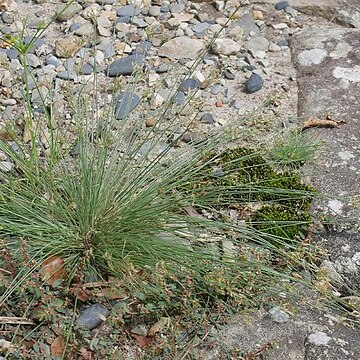Stems setaceous, glabrous and smooth, (1-)5-40 cm by ¼-⅓ mm. Leaves much shorter than the stems, capillary, glabrous (except for the long white hairs at the orifice of the sheaths), slightly scaberulous at the top, ¼-⅓ mm wide. Inflorescence very variable, simple or subcompound, with 1-many spikelets, in Mal. usually very loose, up to 5 cm long. Involucral bracts usually very short, glume-like, or the lower 1-2 setaceous with dilated scarious base, sometimes up to 7 cm. Rays 0-7, filiform, glabrous, smooth, up to 4 cm. Spikelets solitary, oblong-ovate to oblong, acute, rather densely flowered, 3-6 by 1¾-2 mm. Glumes membranous, ovate to broadly ovate, acute, muticous, strongly keeled, with nerveless sides and ciliolate margins, brownish to castaneous, 1¾-2 mm long. Stamens 2; anthers oblong, ¼-⅓ mm. Style ¾-1 mm; stigmas 3, shorter than the style. Nut triquetrous, obovate to broadly obovate, densely granular-puncticulate, stramineous to fumose, 0.7-0.9 by 0.5-0.8 mm; epidermal cells minute, iso-diametric to oblong.
Annual herb, sparsely tufted, 0.06-0.25 m high. Leaf blades up to 160 x 0.25(-0.40) mm flexuous, capillary. Culm scapose, erect to flexuous, ± terete, ridged, ± 0.25 mm in diam. Inflorescence terminal, a compound anthela, up to 4-30 x 20 mm. Subtending bracts 3 or 4, usually shorter than inflorescence; blades capillary. Spikelets ovate to oblong, 3.0-8.0 x 1.3-2.0 mm. Glumes: fertile, boat-shaped, ± broadly ovate, 1.4-1.8 x 0.75-1.70 mm, keel excurrent into minute point or awn. Flowering time Jan.-Apr. Nutlet obovate, 0.5-1.0 x 0.35-0.80 mm, 3-angled, whitish becoming dark brown, surface transversely lineate.
Perennial herb, up to 150 mm tall. Spikelets 1.3-2.0 mm wide, polygonal-cylindric, never clearly 4-ranked in age. Glumes with margins never long ciliate, usually shortly pubescent, golden brown.


